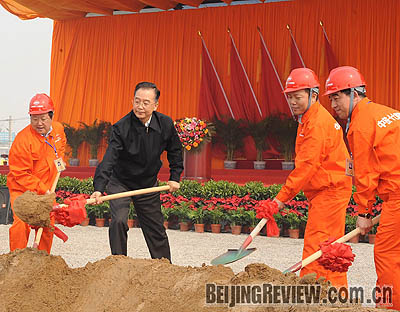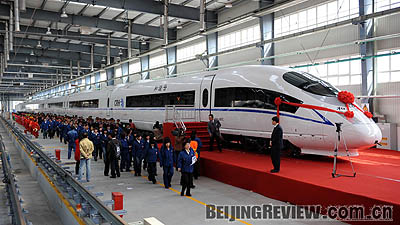|

HIGH PROFILE: Chinese Premier Wen Jiabao (second left) lays the cornerstone with workers at the ground-breaking ceremony of the Beijing-Shanghai Express Railway in Beijing, on April 18 Photo by GAO JIE
On April 18, Premier Wen Jiabao announced the beginning of the construction of the Beijing-Shanghai Express Railway, the longest express railway in the world that has been deliberated over for 18 years. With a total investment of 220.9 billion yuan ($31.6 billion), it's the most costly construction project that the government has undertaken since the founding of the People's Republic of China in 1949.
The express railway, which will be over 1,300 km long, will connect Beijing South Railway Station and Shanghai's Hongqiao Airport. It will also lift the one-way transport capacity between China's two largest cities to 80 million passengers and more than 100 million tons of cargo annually, said the Ministry of Railways (MOR).
During discussions about the line that spanned nearly two decades, both maglev and conventional high-speed wheel-on-track technology were considered for the rail system.
The idea of a maglev system was abandoned due to the immense cost of building it and the State Council finally approved a feasibility report on the line last September.
On April 18, Wang Yongping, a spokesman for the Ministry of Railways announced, "After a lot of discussions and demonstrations, and taking technological and economic factors into account, we decided to use wheel-on-track technology."
The express railway will run parallel to the existing route and have 21 stops. Trains will eventually run at 350 km/h, but in the early stages speed will be kept to 300 km/h, according to MOR. Construction is expected to last five years. When finished, it will take only five hours to travel from Beijing to Shanghai.
Relieving the pressure
Now the flight between Beijing and Shanghai is about two hours while the fastest trains between the two cities take around 11-and-a-half hours to complete the journey. Now most time-conscious business people choose the plane over the train although air tickets are twice as expensive as tickets for fastest trains. The new line will make taking the train more attractive as a five-hour journey compares well with air travel if the time spent traveling to and waiting at the airport is taken into account.
For cargo deliveries, the line will facilitate the transport of coal and mineral resources from the northern regions to the eastern delta. Meanwhile, it will lower the cost of transportation between the two areas, said Wang.
The traffic capacity of the existing Beijing-Shanghai railway line can barely meet the increasing demand.
"The project will ease the pressure on the tight rail transport capacity between the two most populous regions and help promote technological innovation and industrial advancement," said Vice Premier Zhang Dejiang, addressing the inauguration ceremony.
The line will traverse Beijing, Tianjin, Hebei, Shandong, Anhui and Jiangsu before reaching Shanghai. It connects two major economic zones-in the Bohai Bay and the Yangtze River Delta, which account for 6.5 percent of China's total territory. One fourth of the nation's population live in the two economically prosperous regions where local gross domestic product (GDP) accounts for 40 percent of the nation's total.

GROUNDBREAKING: China’s first domestically-produced high-speed train, capable of traveling at 350 km/h, rolls off the production line on April 11 at Tangshan Railway Vehicle Co. The train is scheduled to start operating in August, ahead of the Olympics Photo by YANG SHIYAO
Lu Chunfang, Vice Minister of MOR, said that although railways have existed between Beijing and Shanghai for over a century, cargo and passenger space has been a chronic problem. He said a large proportion of passengers find it difficult to get a train ticket during the holiday travel rushes, and the railway only meets around 35 percent of cargo transportation demand.
"After the completion of this line, passenger trains and cargo trains will travel on separate lines, relieving rail traffic pressure between the two cities," Lu said.
"China's railway service has long fallen short of demand," said Li Heping, a researcher at the China Academy of Railway Sciences. "There are two solutions: building more railways and raising the train speed."
China had raised train speeds six times by April 2007, with trains traveling at more than 200 km/h on 6,227 km of line. By 2020, the total length of such railways will reach 18,000 km and high-speed train services will cover 50,000 km, benefiting 90 percent of China's population.
However, the acceleration of train speeds has failed to solve the problem of passenger and cargo trains becoming congested along the same line. The future development trend is to build separate lines for passenger traffic and for cargo traffic.
State of the art
China's first domestically produced bullet train, which is able to run at 350 km/h, rolled off the production line on April 11.
The train, the latest model in the China Railway High-speed (CRH) series, was produced in the northern city of Tangshan by the China Northern Locomotive and Rolling Stock Industry Corp.
Three such trains will begin service on the new 120-km Beijing-Tianjin route before the Olympics start in August. The pilot operation started on the Beijing-Tianjin route on April 26. In all, 57 such trains are expected to be in commercial operation by the end of 2009.
The Beijing-Tianjin railway is considered a trial line for the Beijing-Shanghai Express Railway.
Besides producing high-speed multiple unit trains that travel beyond 300 km/h, China also developed a whole set of technology for operating rail tracks with speeds of 200 km/h and above during the sixth round of train speed acceleration, said Lu.
China has also developed 62 technical standards which cover rail construction, design, train manufacturing and operation. Building of the Beijing-Shanghai Express Railway will be covered by the standards.
As for the construction of rail beds, China has overcome geological difficulties in laying tracks on soft soil, building railway bridges with gigantic spans and constructing long railway tunnels, unmet before anywhere in the world. By overcoming these technical barriers, China has developed its own rail construction technologies.
Diversified investment
Over half of the investment of the project, or 115 billion yuan ($16.4 billion), has come from the state-owned Beijing-Shanghai High-Speed Railway Co. Ltd. and the remainder will be raised through bank loans, and possibly foreign and indigenous capital attracted through issuing bonds and public listings, said Cai Qinghua, President of Beijing-Shanghai High-Speed Railway Co. Ltd.
The company was set up in late December last year to take charge of the construction.
China Railway Construction Investment Corp., the investment and financing arm of MOR for the country's key railway projects, contributed the largest share, 56.27 percent or 64.7 billion yuan ($9.2 billion), to the Beijing-Shanghai High-Speed Railway Co. Ltd.
Ping An Asset Management Co. Ltd., under the Ping An Group, and the National Council for the Social Security Fund, invested 16 billion yuan ($2.3 billion) and 10 billion yuan ($1.4 billion) respectively.
The remainder came from investment companies in Beijing, Tianjin, Hebei, Shandong, Anhui, Jiangsu, Nanjing and Shanghai, which lie along the projected rail line. These companies have invested with their land for the construction of the line.
Cai estimated all the investment in the Beijing-Shanghai High-Speed Railway could be returned in around 14 years. "Or even shorter if we are allowed to raise ticket prices within an affordable range of passengers," he added. | 